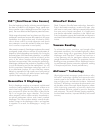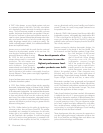
Placement & Room Acoustics 11
back? You have near-field reflections. Stomp your foot.
Can you hear a “boom”? You have standing waves or
large panel resonances such as a poorly supported wall.
Put your head in a small cavity area and talk loudly. Hear
a booming? You’ve just experienced a cavity resonance.
Rules of Thumb
Hard vs. Soft Surfaces
If the front or back wall of your listening room is soft, it
might benefit you to have a hard or reflective wall in
opposition. The ceiling and floor should follow the same
basic guideline as well. However, the side walls should be
roughly the same in order to deliver a focused image.
This rule suggests that a little reflection is good. As a matter
of fact, some rooms can be so “over damped” with carpet-
ing, drapes and sound absorbers that the music system
can sound dull and lifeless. On the other hand, rooms can
be so hard that the system can sound like a gymnasium
with too much reflection and brightness. The point is that bal-
ance is the optimum environment.
Breakup Objects
Objects with complex shapes, such as bookshelves, cabinetry
and multiple shaped walls can help break up those sonic
gremlins and diffuse any dominant frequencies.
Dipolar Speakers and Your Room
MartinLogan electrostatic loudspeakers are known as dipo-
lar radiators. This means that they produce sound from
both their fronts and their backs. Consequently, musical
information is reflected by the wall behind them and may
arrive, either in or out of step, with the information pro-
duced by the front of the speaker.
The low frequencies can either be enhanced or nulled by the
position from the front wall. Your Purity’s have been designed
to be placed two to three feet from the front wall (the wall in
front of the listening position) to obtain the best results; how-
ever, your room may see things differently. So listening to the
difference of the bass response as a result of the changes
in distance from the front wall can allow you to get the best
combination of depth of bass and tonal balance.
Now that you know about reflective surfaces and resonant
objects, you can see how the midrange and high frequen-
cies can be affected. The timing of the initial wave as it
radiates to your ears, and then the reflected information as
it arrives at your ears later in time, can result in confusion of
the precious timing information that carries the clues to imag-
ing. Consequently the result is blurred imaging and excessive
brightness. Soft walls, curtains, wall hangings, or sound
dampeners (your dealer can give you good information here)
can be effective if these negative conditions occur.
Solid Footing
After living and experimenting with your Purity speakers, you
may want to use ETC (energy transfer coupler) Spikes (see
figure 7), which are available from your local MartinLogan
dealer or from the Xtatic shop at www.martinlogan.com.
With the use of these spikes, the Purity will become more
firmly planted on the floor and, consequently, bass will tight-
en and imaging will become more coherent and detailed.
It is best not to implement the spikes, however, until you are
secure in the positioning, as the spikes can damage the
floor if the speaker is moved. MartinLogan ETC spikes will
fit any common 1/4” x 20 thread insert that may be found
on your other audio equipment (racks, etc.)
Spike Installation Instructions:
1 Carefully place your speaker on its side.
2 Remove existing feet. Thread new spikes into holes
and screw them in all of the way. If the speaker does
not sit level loosen one spike until level is achieved.
3 Tighten the jam nut snugly by hand. Do not over tighten.
4 Right the speaker.
Caution: Make sure your hands and any cabling are
clear of the spikes. Do not slide speaker as spikes are
sharp and can damage your floor or carpet.
5 Adjust to level by rotating spikes. Tighten the jam nut
securely when satisfied that speaker is level. Caution:
Walking the speaker may result in a broken spike.
Figure 7. The ETC Spike.


















